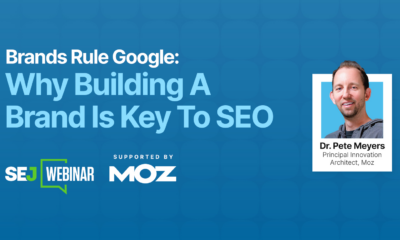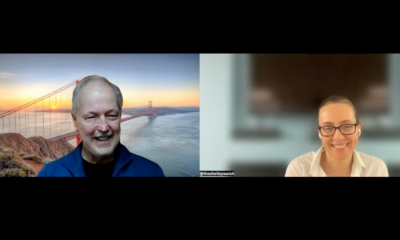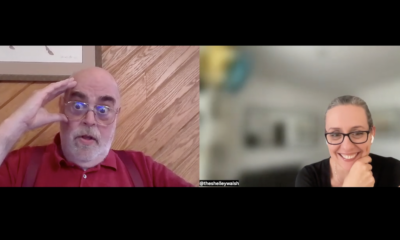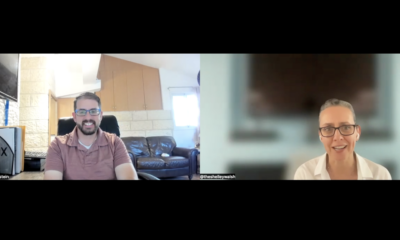MARKETING
Do You Really Need To Measure Your Content’s Impact on Brand Value? [Rose-Colored Glasses]
Once upon a time, I had a marketing boss who would ask me about our efforts at brand building: What were the results? What value did they add to the business?
My answer was always the same: “good things.”
In our 2022 B2B Content Marketing Benchmarks, Budgets, and Trends research, we find 80% of marketers say “creating brand awareness” is the goal they achieved using content marketing. Interestingly, “building credibility and trust” is number two with 75%, “educating audiences” follows at 70%, and “building loyalty with existing clients/customers” is 60%.
Arguably, these top four goals are all associated with brand value. Whether it’s wider awareness and recall, deeper trust or affinity, differentiation through education, or additional value to stay loyal – it’s all about increasing the value of our brand.
If it’s such an important goal, why is brand value so hard to measure?
Marketers’ top four #content goals are all associated with brand value. Why is that so hard to measure, asks @Robert_Rose via @CMIContent. Click To Tweet
Pushback on vanity metrics
We are desperate to measure brand awareness. Well, to be clear, there isn’t much today’s businesses aren’t desperate to measure. There are myriad articles on the difficulty of associating transactional data with brand value. When you find articles that recommend brand measurement tactics, most rely on the same vanity metrics used for other elements of marketing strategies. They direct you to look at the growth of direct traffic, referral traffic, earned media coverage, or social media share of voice.
We see this in our research. Marketers mention those metrics when describing which have provided the most insight in the last 12 months. Website engagement is top (69%), traffic is third (65%), email engagement is fourth (64%), and social media analytics is fifth (51%). (Conversions rank No. 2 at 67%.)
But anyone who has tried to argue for more money for brand and/or content marketing will tell you that those “vanity metrics” won’t get you very far. The pushback is that more traffic doesn’t necessarily mean that the brand has more unaided or aided recall. It could mean the brand suddenly ranked well for an unbranded search term. Nor does “website engagement” mean credibility and trust have grown with the target audience. It could mean people are scrutinizing the digital content more because they actually don’t trust the brand. More engagement from email could be because the topic is finally relevant to the audience rather than – yep, you guessed it – the brand.
Put simply, many of those vanity metrics may have nothing to do with increasing or decreasing the value of the brand, and ironically, some may run counter to it.
Many vanity metrics have nothing to do with measuring the brand’s value, says @Robert_Rose via @CMIContent. Click To Tweet
ADVERTISEMENT![Do You Really Need To Measure Your Content's Impact on Brand Value? [Rose-Colored Glasses] 1651661024 12 Content Marketing Measurement Guide 23 Definitions To Know](https://articles.entireweb.com/wp-content/uploads/2022/05/1651661024_12_Content-Marketing-Measurement-Guide-23-Definitions-To-Know.png)
The Definitive Guide to Content Analytics: Understanding the Data That Matters Most for Successful Marketing
Want to optimize your content? Start with the right metrics and measure how your content is engaging with your audience. Get the guide to learn more!
Transactions are easy; triggers are hard
Now, before fans of brand-building value get depressed, there are plenty of ways to measure if brand building with content is working. The key is to put an objective behind the effort and then build testable and focused measurability into it. For example:
- About five years ago, Salesforce had a real problem with its brand and clarity of purpose. Nobody understood what Salesforce did. In 2019, they launched a full-scale effort with content marketing and paid media to provide for better unaided brand recall and clarity. Put simply, they wanted people to articulate an answer to “what does Salesforce do?” Recently, Salesforce measured (through a study) the effectiveness of its efforts and saw a huge improvement in general brand clarity.
- A financial services organization wanted to increase its brand trust with its existing investors and financial advisors. We conducted a general brand trust survey with their audiences to compare competitors and even mainstream news media outlets that covered financial services. One year later, we conducted the same study again. This time we measured the same kind of audience but added a segment of their customer base –subscribers to their blog and thought leadership platform. The organization performed better in the industry (speaking specifically to their overall branding efforts such as TV ads, print, and content). But the subscriber segment performed even better – ranking the organization even higher than some of the mainstream news sources when it came to trust.
- In 2018, BMO Harris Bank wanted to increase its brand awareness with younger people just beginning their journey to financial independence. They launched a brand awareness campaign by partnering with The Onion’s humor-focused content agency to develop a series of videos promoting a fictional mobile banking app. The parody plays on socially popular apps. It features face filters (making faces look like ATM machines), couch surfing (in a bank vault), and the opportunity to swipe right on potential dates based on the value of their checking accounts. BMO Harris Bank saw a huge lift in brand awareness among the younger demographic as measured by how many downloaded the real BMO Harris banking app.
But hold on, sure, you measured if brand building with content was working, but the question may still be, “So what?”
So what if more people know what Salesforce does? So what if the financial advisors and investors have more trust in the financial services company than they do CNBC? So what if young people downloaded the app?
What real value does any of that provide for the business? More revenue? More savings?
You can easily measure more traffic, more votes, more engagement, and more downloads. It’s identifying what inspired the action that benefited the company that’s hard. Put simply: Measuring transactions is easy; measuring triggers is hard.
Measuring transactions with #content is easy. Measuring triggers that motivate action is hard, says @Robert_Rose via @CMIContent. Click To Tweet
Being satisfied with good things
We have spent our careers building business systems for consistency. We have a laser focus on removing operational conflicts and anything that takes away from consistent, predictable, harmonious processes.
We believe in measurability as a foundation for that predictability. The old saying, “If you can’t measure it, you can’t manage it,” comes out of this thinking. This trope is sometimes morphed into “If you can’t measure it, it doesn’t count.” And this, of course, is complete nonsense.
The saying “If you can’t measure it, it doesn’t count” is complete nonsense, says @Robert_Rose via @CMIContent. Click To Tweet
Over 30 years of marriage, I’ve learned that doing good things for my wife provides good things in return. I have no idea how much time, effort, or money I spend on these things (though I’d bet it’s … ummm … significant). I could easily measure the transactions, but even if I did, it would be impossible to connect them value for value to the good things I get in return.
Think for a moment about the love you have for someone special in your life. Maybe it’s your partner, mom, dad, or children — or even a dog. How much love is there? Have you measured it lately? Well, if you can’t measure it, it doesn’t count, right?
Sometimes the most satisfying and accurate answer to the question of what happens when we engage in brand building is simply “good things happen.” Yes, more revenue, more savings, better customers, more trust, more brand equity, and more profitability. But you’re just not going to try and quantify it.
How much brand building should we do?
My answer? Enough. Do enough and good things will happen.
Get Robert’s take on content marketing industry news in just three minutes:
https://www.youtube.com/watch?v=videoseries
Cover image by Joseph Kalinowski/Content Marketing Institute
!function(f,b,e,v,n,t,s)
{if(f.fbq)return;n=f.fbq=function(){n.callMethod?
n.callMethod.apply(n,arguments):n.queue.push(arguments)};
if(!f._fbq)f._fbq=n;n.push=n;n.loaded=!0;n.version=’2.0′;
n.queue=[];t=b.createElement(e);t.async=!0;
t.src=v;s=b.getElementsByTagName(e)[0];
s.parentNode.insertBefore(t,s)}(window, document,’script’,
‘https://connect.facebook.net/en_US/fbevents.js’);
fbq(‘init’, ‘1432232210459613’);
fbq(‘track’, ‘PageView’);

















You must be logged in to post a comment Login